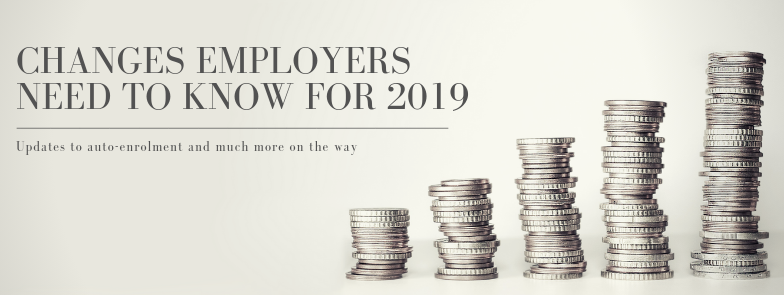
There are many changes on the way for employers in 2019 and beyond, some of which will come at an extra cost to businesses. Below we take a look at what to expect, so you can be prepared.
Automatic Enrolment
Since being introduced in 2012, employers must ensure to enrol employees into a pension savings scheme. The enrolment means that workers and their employers are obligated to pay into a pension scheme, unless the employee chooses to opt out. In April 2019 the amount paid into a scheme will rise to 5% by employees and 3% by employers. It is hoped that by automatically enrolling employees into pension schemes, they will be encouraged to adjust their attitudes towards saving for their retirement.
National Minimum Wage
Another cost arriving for employers is the rise in the hourly National Minimum Wage (NMW) and National Living Wage (NLW) rates. Also, being introduced in April 2019, the NMW will be increased from £7.83 to £8.21 and must be paid to all employees aged over 25. Employers can volunteer to pay the higher rate NLW but it is not mandatory.
Payslips
From April 2019, it will be compulsory to provide payslips to employees. These can be provided in a printed format or digitally, whichever the employer chooses. Exceptions to this new law include contractors and freelancers, who are not obliged to receive payslips. The payslip must be provided before or on the employee’s payday. According to law, the minimum a payslip must include are the earnings before and after deductions and the amounts for deductions which may change from period to period.
Pensions Dashboard
It is hoped the new pensions dashboard will let savers see exactly how much money they are likely to get in retirement “at the touch of a screen” and help recover up to £20bn in ‘lost pensions’. There has been much back and forth on this subject, but the government have recently given their backing to the project and have called upon professionals in the industry to help build this new platform.
The government’s plans will include a series of online dashboards rather than a single one. The first dashboard is expected to launch in 2019 after a feasibility report was published, and it is likely that more will follow in the coming months and years once the necessary consumer protections are in place. Pensions minister Guy Opperman described the plans as a major milestone that would help improve retirement planning and result in more engaged and better-informed savers.
Self-Employed Pensions
Unlike those working as employees, a self-employed individual is not automatically enrolled into any pension scheme. This means they also do not receive any contributions from an employer, and no contributions are being made towards their retired life, leaving them at a huge disadvantage. The government has promised a consultation on this issue and will discuss how they can help individuals who are self-employed to save for retirement.
If you would like to find out more details on anything discussed above then please contact us for further information.




